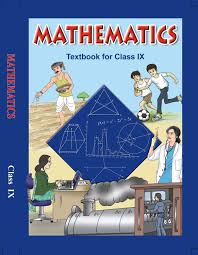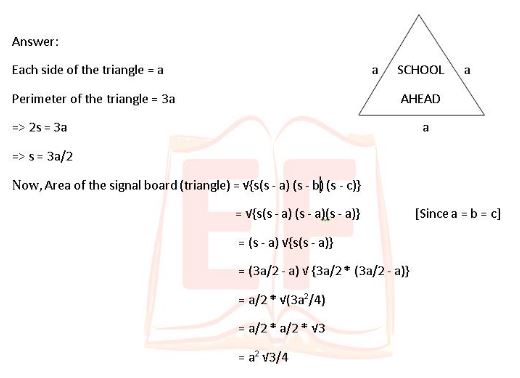Class 9 - Mathematics
Herons Formula - Exercise 12.1

Top Block 1
Exercise 12.1
Question : 1 : A traffic signal board, indicating ‘SCHOOL AHEAD’, is an equilateral triangle with side ‘a’. Find the area of the signal board, using Heron’s formula.
If its perimeter is 180 cm, what will be the area of the signal board?
Answer :

Hence, area of the signal board = a2 √3/4
Now, perimeter = 180 cm
Each side of the triangle = 180/3 = 60 cm
Area of the triangle = (60)2/4 * √3
= (3600 * √3)/4
= 900√3 cm2
Question : 2 : The triangular side walls of a flyover have been used for advertisements. The sides of the walls are 122 m, 22 m and 120 m (see Fig.).
The advertisements yield an earning of Rs 5000 per m2 per year. A company hired one of its walls for 3 months. How much rent did it pay?

Mddle block 1
Answer :
Here, we first find the area of the triangular side walls.
a = 122 m, b = 120 m and c = 22 m
Now, perimeter = 122 + 120 + 22
⇒ 2s = 264
⇒ s = 264/2
⇒ s = 132 m
Now, area of triangular side wall = √{s(s – a)(s – b)(s – c)}
= √{132(132 – 122)(132 – 120)(132 -22)}
= √{132 * 10 * 12 * 110}
= 1320 m2
Rent of 1 m2 of the wall for 1 year = Rs 5000
So, Rent of 1 m2 of the wall for 1 month = Rs 5000/12
So, Rent of the complete wall (1320 m2) for 3 months = Rs (5000/12) * 1320 * 3
= Rs 16,50,000
Question : 3: There is a slide in a park. One of its side walls has been painted in some colour with a message “KEEP THE PARK GREEN AND CLEAN” (see Fig.).
If the sides of the wall are 15 m, 11 m and 6 m, find the area painted in colour.

Answer :
Here, a = 15 m, b = 11 m and c = 6 m
Now, perimeter = 15 + 11 + 6
⇒ 2s = 32
⇒ s = 32/2
⇒ s = 16 m
Now, area of triangle = √{s(s – a)(s – b)(s – c)}
= √{16(16 – 15)(16 – 11)(16 – 6)}
= √{16 * 1 * 5 * 10}
= 20√2 m2
Hence, the area painted in colour = 20√2 m2
Question : 4: Find the area of a triangle two sides of which are 18 cm and 10 cm and the perimeter is 42 cm.
Answer :
Here a = 18 cm, b = 10 cm, c = ?
Perimeter of the triangle = 42 cm
⇒ a + b + c = 42
⇒ 18 + 10 + c = 42
⇒ c = 42 – 28 = 14
Now, s = (a + b + c)/2
⇒ s = 42/2 = 21 cm
Now, area of triangle = √{s(s – a)(s – b)(s – c)}
= √{21(21 – 18)(21 – 10)(21 – 14)}
= √{21 * 3 * 11 * 7}
= 7 * 3 * √11
= 21√11 cm2
Question : 5: Sides of a triangle are in the ratio of 12 : 17 : 25 and its perimeter is 540 cm. Find its area.
Answer :
Let the sides of the triangle be 12x cm 17x cm and 25x cm.
Perimeter of the triangle = 540 cm
⇒ 12x + 17x + 25x = 540
⇒ 54 x = 540
⇒ x = 540/54 = 10
So, sides of the triangle are (12 * 10) cm, (17 * 10) cm and (25 * 10) cm i.e., 120 cm, 170 cm
and 250 cm.
Now, suppose a = 120 cm, b = 170 cm, c = 250 cm,
So, s = (a + b + c) = (120 + 170 + 250)/2 = 540/2 = 270 cm
Now, area of triangle = √{s(s – a)(s – b)(s – c)}
= √{270(270 – 120)(270 – 170)(270 – 250)}
= √{270 * 150 * 100 * 20}
= 9000 cm2
Question : 6: An isosceles triangle has perimeter 30 cm and each of the equal sides is 12 cm. Find the area of the triangle.
Answer :
Here, a = b = 12 cm,
Also, a + b + c = 30
⇒ 12 + 12 + c = 30
⇒ c = 30 – 24 = 6
So, s = (a + b + c)/2 = (12 + 12 + 6)/2 = 30/2 = 15 cm
Now, Area of the triangle = √{s(s – a)(s – b)(s – c)}
= √{15(15 – 12)(15 – 12)(15 – 6)}
= √{15 * 3 * 3 * 9}
= 9√15 cm2

